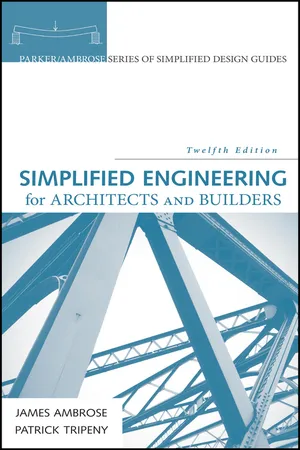
Simplified Engineering for Architects and Builders
- English
- ePUB (mobile friendly)
- Available on iOS & Android
Simplified Engineering for Architects and Builders
About this book
Simplified Engineering for Architects and Builders is the go-to reference on structural design, giving architects and designers a concise introduction to the structures commonly used for typical buildings. The clear, accessible presentation is designed to give you the essential engineering information you need without getting bogged down in excess math, making this book an ideal reference for busy design professionals. This new 12th edition has been completely revised to reflect the latest standards and practices. The instructor site includes a complete suite of teaching resources, including an instructor's manual.
Structural design is an essential component of the architect's repertoire, and engineering principles are at the foundation of every sound structure. You need to know the physics, but you don't necessarily need to know all of the math. This book gives you exactly what you need without losing you in a tangle of equations, so you can quickly grasp and apply the material.
- Understand fundamental concepts like forces, loading, and reactions
- Learn how to design for wood, steel, or concrete construction
- Study structural design standards and develop sound structural systems
- Determine the best possible solutions to difficult design challenges
The industry-leading reference for over 80 years, Simplified Engineering for Architects and Builders is the definitive guide to practical structural design.
Frequently asked questions
- Essential is ideal for learners and professionals who enjoy exploring a wide range of subjects. Access the Essential Library with 800,000+ trusted titles and best-sellers across business, personal growth, and the humanities. Includes unlimited reading time and Standard Read Aloud voice.
- Complete: Perfect for advanced learners and researchers needing full, unrestricted access. Unlock 1.4M+ books across hundreds of subjects, including academic and specialized titles. The Complete Plan also includes advanced features like Premium Read Aloud and Research Assistant.
Please note we cannot support devices running on iOS 13 and Android 7 or earlier. Learn more about using the app.
Information
Part I
Fundamental Functions of Structures
Chapter 1
Investigation of Forces, Force Systems, Loading, and Reactions
1.1 Properties of Forces


Table of contents
- Cover
- Title Page
- Copyright
- Table of Contents
- Preface to the Twelfth Edition
- Preface to the First Edition
- Introduction
- Part I: Fundamental Functions of Structures
- Part II: Wood Construction
- Part III: Steel Construction
- Part IV: Concrete Construction
- Part V: Structural Systems for Buildings
- Appendix A: Properties of Sections
- Glossary
- References
- Quick Reference to Useful Data
- Index
- End User License Agreement